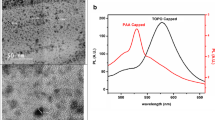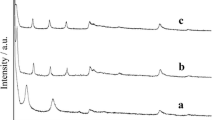Abstract
The persistence of bacterial infections in humans causes severe adverse health consequences and uncertainties in the global economy. It is of great advantage to develop a rapid tool for the earlier diagnosis and treatment of pathogenic infections. In this work, an active polythiophene derivative containing reactive pentafluorophenyl (PFP) ester groups was prepared via Fe3+-catalyzed oxidative polymerization using PFP thiophene-3-acetate as the monomer. The active polythiophene derivative was conjugated with N,N-dimethyl-1,3-propanediamine via ester-amine reaction, followed by quaternization with 1-bromobutane. The resultant polythiophene derivative (QPDMAPTA) possesses the quaternary ammonium salt groups on its side chain and shows cationic zeta potential of + 12.79 eV at neutral pH. The as-prepared QPDMAPTA exhibits high-level antibacterial action against gram-positive bacteria (Staphylococcus aureus (S. aureus), Staphylococcus epidermidis (S. epidermidis), and methicillin-resistant S. aureus) as compared with gram-negative bacteria (Escherichia coli (E. coli) and Pseudomonas aeruginosa (P. aeruginosa)). Furthermore, the zeta potential measurements show higher uptake of QPDMAPTA by gram-positive bacteria than the gram-negative bacteria, which depicts the active role of the biological interactions with the charged QPDMAPTA in its differential uptake and bactericidal effect. This phenomenon also facilitates the identification of gram-positive bacteria by observing the color changes of collected bacterial cakes before and after treatment with QPDMAPTA. The fluorescent nature of QPDMAPTA can be used for imaging and detection of gram-positive bacteria via adopting a fluorescent technique.








Similar content being viewed by others
References
Shin C, Lee HN, Ryu JS et al (2018) Rapid naked-eye detection of Gram-positive bacteria by vancomycin-based nano-aggregation. RSC Adv 8:25094–25103
Lee MMS, Xu W, Zheng L et al (2020) Ultrafast discrimination of Gram-positive bacteria and highly efficient photodynamic antibacterial therapy using near-infrared photosensitizer with aggregation-induced emission characteristics. Biomaterials 230:119582
Zhou C, Song H, Zhang F et al (2019) A facile method to fabricate an antimicrobial coating based on poly(1-vinyl-3-allylimidazolium iodide) (PAVI) and poly(ethylene glycol) dimethyl acrylate (PEGDMA). Polym Bull 76:5433–5449
Chaiarwut S, Niyompanich J, Ekabutr P et al (2020) Development and characterization of antibacterial hydroxyapatite coated with mangosteen extract for bone tissue engineering. Polym Bull. https://doi.org/10.1007/s00289-020-03284-3
Choi SK, Myc A, Silpe JE et al (2013) Dendrimer-based multivalent vancomycin nanoplatform for targeting the drug-resistant bacterial surface. ACS Nano 7:214–228
Jiao Y, Niu L-n, Ma S et al (2017) Quaternary ammonium-based biomedical materials: state-of-the-art, toxicological aspects and antimicrobial resistance. Prog Polym Sci 71:53–90
Ahmed HB, Emam HE, Mashaly HM et al (2018) Nanosilver leverage on reactive dyeing of cellulose fibers: color shading, color fastness and biocidal potentials. Carbohydr Polym 186:310–320
Emam HE (2019) Arabic gum as bio-synthesizer for Ag–Au bimetallic nanocomposite using seed-mediated growth technique and its biological efficacy. J Polym Environ 27:210–223
Emam HE, Darwesh OM, Abdelhameed RM (2020) Protective cotton textiles via amalgamation of cross-linked Zeolitic imidazole frameworks. Ind Eng Chem Res 59:10931–10944
Emam HE (2019) Antimicrobial cellulosic textiles based on organic compounds. 3 Biotech 9(1):29
Gong H, Zhang K, Dicko C et al (2019) Ag–Polymer nanocomposites for capture, detection, and destruction of bacteria. ACS Appl Nano Mater 2:1655–1663
Jokerst JC, Adkins JA, Bisha B et al (2012) Development of a paper-based analytical device for colorimetric detection of select foodborne pathogens. Anal Chem 84:2900–2907
Esterhuizen-Londt M, Downing S, Downing TG (2011) Improved sensitivity using liquid chromatography mass spectrometry (LC-MS) for detection of propyl chloroformate derivatised beta-n-methylamino-L-alanine (BMAA) in cyanobacteria. Water SA 37:133–138
Abrami M, Ascenzioni F, Di Domenico EG et al (2018) A novel approach based on low-field NMR for the detection of the pathological components of sputum in cystic fibrosis patients. Magn Reson Med 79:2323–2331
Tominaga T (2018) Rapid detection of Klebsiella pneumoniae, Klebsiella oxytoca, Raoultella ornithinolytica and other related bacteria in food by lateral-flow test strip immunoassays. J Microbiol Methods 147:43–49
Banerjee R, Teng CB, Cunningham SA et al (2015) Randomized trial of rapid multiplex polymerase chain reaction-based blood culture identification and susceptibility testing. Clin Infect Dis 61:1071–1080
Franco-Duarte R, Cernakova L, Kadam S et al (2019) Advances in chemical and biological methods to identify microorganismsfrom past to present. Microorganisms 7:130
Law JW-F, Ab Mutalib N-S, Chan K-G et al (2015) Rapid methods for the detection of foodborne bacterial pathogens: principles, applications, advantages and limitations. Front Microbiol 5:770
Das S, Chatterjee DP, Ghosh R et al (2015) Water soluble polythiophenes: preparation and applications. RSC Adv 5:20160–20177
Tang J, Chu B, Wang J et al (2019) Multifunctional nanoagents for ultrasensitive imaging and photoactive killing of gram-negative and gram-positive bacteria. Nat Commun 10:4057
Ahmed HB, Emam HE (2020) Environmentally exploitable biocide/fluorescent metal marker carbon quantum dots. RSC Adv 10:42916–42929
Mawad D, Gilmore K, Molino P et al (2011) An erodible polythiophene-based composite for biomedical applications. J Mater Chem 21:5555–5560
Zhu C, Yang Q, Liu L et al (2011) Multifunctional cationic poly(p-phenylene vinylene) polyelectrolytes for selective recognition, imaging, and killing of bacteria over mammalian cells. Adv Mater 23:4805–4810
Parthasarathy A, Pappas HC, Hill EH et al (2015) Conjugated polyelectrolytes with imidazolium solubilizing groups. Properties and application to photodynamic inactivation of bacteria. ACS Appl Mater Interfaces 7:28027–28034
Bai H, Yuan H, Nie C et al (2015) A supramolecular antibiotic switch for antibacterial regulation. Angew Chem Int Ed 54:13208–13213
Bazireh E, Sharif M (2020) Polythiophene-coated multi-walled carbon nanotube-reinforced epoxy nanocomposites for enhanced mechanical, electrical and thermal properties. Polym Bull 77:4537–4553
Sarvari R, Massoumi B, Zareh A et al (2020) Porous conductive and biocompatible scaffolds on the basis of polycaprolactone and polythiophene for scaffolding. Polym Bull 77:1829–1846
Zeglio E, Rutz AL, Winkler TE et al (2019) Conjugated polymers for assessing and controlling biological functions. Adv Mater 31:1806712
Zhang P, Xu C, Zhou X et al (2020) Cationic conjugated polymers for enhancing beneficial bacteria adhesion and biofilm formation in gut microbiota. Coll Surf B 188:110815
Sista P, Ghosh K, Martinez JS et al (2014) Polythiophenes in biological applications. J Nanosci Nanotechnol 14:250–272
Huang Y, Pappas HC, Zhang L et al (2017) Selective imaging and inactivation of bacteria over mammalian cells by imidazolium-substituted polythiophene. Chem Mater 29:6389–6395
Wang Y, Schanze KS, Chi EY et al (2013) When worlds collide: interactions at the interface between biological systems and synthetic cationic conjugated polyelectrolytes and oligomers. Langmuir 29:10635–10647
Parthasarathy A, Goswami S, Corbitt TS et al (2013) Photophysics and light-activated biocidal activity of visible-light-absorbing conjugated oligomers. ACS Appl Mater Interfaces 5:4516–4520
Ning LG, Wang S, Hu XF et al (2017) Vancomycin-conjugated polythiophene for the detection and imaging of gram-positive bacteria. J Mater Chem B 5:8814–8820
Shao M, He Y, Hong K et al (2013) A water-soluble polythiophene for organic field-effect transistors. Polym Chem 4:5270–5274
Wang F, Li M, Wang B et al (2015) Synthesis and characterization of water-soluble polythiophene derivatives for cell imaging. Sci Rep 5:7617
Emam HE, Ahmed HB (2021) Antitumor/antiviral carbon quantum dots based on carrageenan and pullulan. Int J Biol Macromol 170:688–700
Muñoz-Bonilla A, Fernández-García M (2012) Polymeric materials with antimicrobial activity. Prog Polym Sci 37:281–339
Zhao Q, Li J, Zhang X et al (2016) Cationic oligo(thiophene ethynylene) with broad-spectrum and high antibacterial efficiency under white light and specific biocidal activity against S. aureus in dark. ACS Appl Mater Interfaces 8:1019–1024
Jennings MC, Minbiole KPC, Wuest WM (2015) Quaternary ammonium compounds: an antimicrobial mainstay and platform for innovation to address bacterial resistance. ACS Infect Dis 1:288–303
Kwaśniewska D, Chen Y-L, Wieczorek D (2020) Biological activity of quaternary ammonium salts and their derivatives. Pathogens 9:459
Brown S Jr, Santa Maria Jr JP, Walker S (2013) Wall teichoic acids of gram-positive bacteria. Ann Rev Microbiol 67:313–336
Rosenfeld Y, Shai Y (2006) Lipopolysaccharide (endotoxin)-host defense antibacterial peptides interactions: role in bacterial resistance and prevention of sepsis. Biochim Biophys Acta Biomembr 1758:1513–1522
Zamani E, Chatterjee S, Changa T et al (2019) Mechanistic understanding of the interactions of cationic conjugated oligo- and polyelectrolytes with Wild-type and Ampicillin-resistant Escherichia coli. Sci Rep 9:20411
Halder S, Yadav KK, Sarkar R et al (2015) Alteration of zeta potential and membrane permeability in bacteria: a study with cationic agents. SpringerPlus 4:672
Choi Y, Hwang JH, Lee SY (2018) Recent trends in nanomaterials-based colorimetric detection of pathogenic bacteria and viruses. Small Methods 2:1700351
DeBritto S, Gajbar TD, Satapute P et al (2020) Isolation and characterization of nutrient dependent pyocyanin from Pseudomonas aeruginosa and its dye and agrochemical properties. Sci Rep 10:1542
Acknowledgements
This research was supported by National Natural Science Foundation of China (21504072, 51741304, and 52073234), Natural Science Foundation of Chongqing (cstc2019jcyj-msxmX0363), innovation teams in colleges and universities of Chongqing (CXQT20005) and Chongqing Engineering Research Center for Micro-Nano Biomedical Materials and Devices.
Author information
Authors and Affiliations
Corresponding author
Ethics declarations
Conflict of interest
The authors declare that they have no conflict of interest.
Additional information
Publisher's Note
Springer Nature remains neutral with regard to jurisdictional claims in published maps and institutional affiliations.
Rights and permissions
About this article
Cite this article
Ren, X., Hao, J., Guo, L. et al. Quaternary ammonium functionalized cationic polythiophene for the detection and imaging of gram-positive bacteria. Polym. Bull. 79, 2747–2761 (2022). https://doi.org/10.1007/s00289-021-03642-9
Received:
Revised:
Accepted:
Published:
Issue Date:
DOI: https://doi.org/10.1007/s00289-021-03642-9




